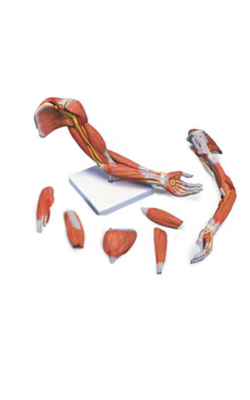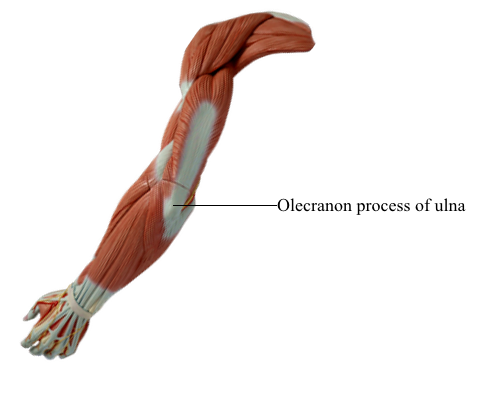Main Model

26 Olecranon process of ulna

Ulna
The ulna is the stabilizing bone of the forearm and is the medial and longer of the two forearm bones. Its more massive proximal end is specialized for articulation with the humerus proximally, and the head of the radius laterally. For articulation with the humerus, the ulna has two prominent projections: (1) the olecranon, which projects proximally from its posterior aspect (forming the point of the elbow), and serves as a short lever for extension of the elbow, and (2) the coronoid process, which projects anteriorly.
The olecranon and coronoid processes form the walls of the trochlear notch, which in profile resembles the jaws of a crescent wrench as it “grips” (articulates with) the trochlea of the humerus. The articulation between the ulna and humerus primarily allows only flexion and extension of the elbow joint, although a small amount of abduction - adduction occurs during pronation and supination of the forearm. Inferior to the coronoid process is the tuberosity of the ulna for attachment of the tendon of the brachialis muscle.
On the lateral side of the coronoid process is a smooth, rounded concavity, the radial notch, which receives the broad periphery of the head of the radius. Inferior to the radial notch on the lateral surface of the ulnar shaft is a prominent ridge, the supinator crest. Between it and the distal part of the coronoid process is a concavity, the supinator fossa. The deep part of the supinator muscle attaches to the supinator crest and fossa.
The shaft of the ulna is thick and cylindrical proximally, but it tapers, diminishing in diameter, as it continues distally. At the narrow distal end of the ulna is a small but abrupt enlargement, the disc-like head of the ulna with a small, conical ulnar styloid process. The ulna does not reach - and therefore does not participate in - the wrist (radiocarpal) joint.